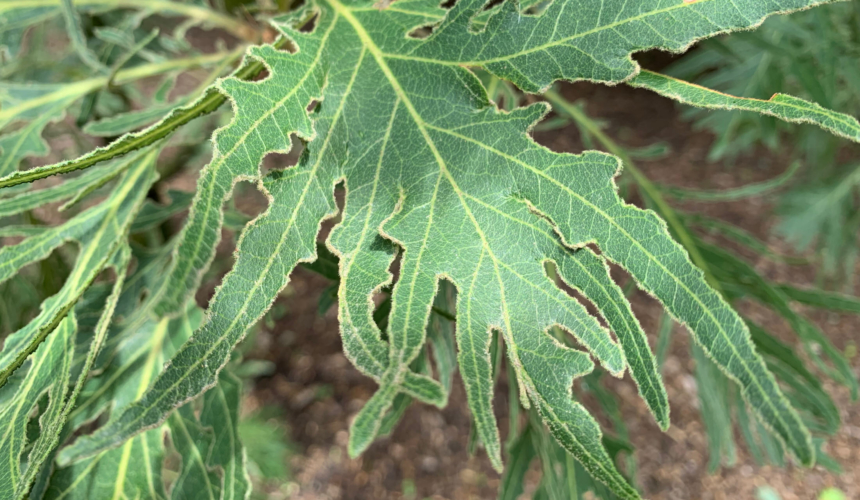Self-Guided TREE Tour
Grounds For Sculpture’s rich landscape offers much to explore – from gentle rolling berms covered with roses or wildflowers, to an array of lotus in the water gardens, and thousands of native and exotic trees and flowers.
Download our self-guided TREE TOUR here (which covers the 78 trees listed below), or, use our INTERACTIVE MAP to explore the gardens here.
| ID | Common Name | Latin Name |
|---|---|---|
| 1 | Hinoki Falsecypress | Chamaecyparis obtusa 'Nana' |
| 2 | Weeping White Crabapple | Malus 'White Cascade' |
| 3 | Strawberry Parfait Crabapple | Malus 'Strawberry Parfait' |
| 4 | Weeping European Beech | Fagus sylvatica 'Pendula' |
| 5 | Weeping Norway Spruce | Picea abies 'Pendula' |
| 6 | Lombardy Poplar | Populus nigra 'Italica' |
| 7 | Camperdown Elm | Ulmus glabra 'Camperdownii' |
| 8 | Japanese Maple Courtyard | Acer palmatum |
| 9 | Southern Magnolia | Magnolia grandiflora |
| 10 | Common Crapemyrtle | Lagerstroemia indica |
| 11 | Fernleaf European Beech | Fagus sylvatica 'Asplenifolia' |
| 12 | Chinese Elm | Ulmus parvifolia |
| 13 | Red Leaf Japanese Maple | Acer palmatum 'Bloodgood' |
| 14 | Winter King Hawthorne | Crataegus viridis 'Winter King' |
| 15 | Copper Beech | Fagus sylvatica 'Cuprea' |
| 16 | Japanese White Pine | Pinus parviflora |
| 17 | Dragon Eye Pine | Pinus densiflora 'Oculus-draconis' |
| 18 | Japanese Black Pine | Pinus thunbergiana |
| 19 | Blue Atlas Cedar | Cedrus atlantica 'Glauca' |
| 20 | Harry Lauder's Walking Stick | Corylus avellana 'Contorta' |
| 21 | American Beech | Fagus grandifolia |
| 22 | Weeping Purple Beech | Fagus sylvatica 'Purpurea Pendula' |
| 23 | Weeping White Pine | Pinus strobus 'Pendula' |
| 24 | Himalayan Pine | Pinus wallichiana |
| 25 | Moss Sawara Falsecypress | Chamaecyparis pisifera 'Squarrosa' |
| 26 | Variegated Himalayan Pine | Pinus wallichiana 'Zebrina' |
| 27 | Oriental Spruce | Picea orientalis |
| 28 | Serbian Spruce | Picea omorika |
| 29 | Panicled Goldenraintree | Koelreuteria paniculata |
| 30 | Japanese Horsechestnut | Aesculus turbinata |
| 31 | Paperbark Maple | Acer griseum |
| 32 | Shubert Cherry | Prunus virginiana 'Schubert' |
| 33 | Lacebark Pine | Pinus bungeana |
| 34 | Japanese Zelkova | Zelkova serrata |
| 35 | Fastigiate Eastern White Pine | Pinus strobus 'Fastigiata' |
| 37 | Japanese Weeping Cherry | Prunus serrulata 'Pendula' |
| 38 | Tanyosho Pine | Pinus densiflora 'Umbraculifera' |
| 39 | Bosnian Pine | Pinus leucodermis |
| 40 | Golden Deodar Cedar | Cedrus deodara 'Aurea' |
| 41 | Golden Thread Leaf Falsecypress | Chamaecyparis pisifera 'Filifera Aurea' |
| 42 | Persian Parrotia | Parrotia persica |
| 43 | Eastern Redbud | Cercis canadensis |
| 44 | Scotch Pine | Pinus sylvestris |
| 45 | Weeping Needle Juniper | Juniperus rigida 'Pendula' |
| 46 | Limber Pine | Pinus flexilis |
| 47 | Japanese Umbrella Pine | Sciadopitys verticillata |
| 48 | Colorado Blue Spruce | Picea pungens 'Glauca' |
| 49 | Katsura Tree | Cercidiphyllum japonicum |
| 50 | River Birch | Betula nigra |
| 51 | Star Magnolia | Magnolia stellata |
| 52 | American Sycamore | Platanus occidentalis |
| 53 | Weeping Blue Atlas Cedar | Cedrus atlantica 'Glauca Pendula' |
| 54 | Red Horsechestnut | Aesculus x carnea |
| 55 | European Hornbeam | Carpinus betulus |
| 56 | Willow Oak | Quercus phellos |
| 57 | Bald Cypress | Taxodium distichum |
| 58 | Golden Variegated Sweetgum | Liquidambar styraciflua 'Variegata' |
| 59 | American Sweetgum | Liquidambar styraciflua |
| 60 | Austrian Pine | Pinus nigra |
| 61 | Littleleaf Linden | Tilia cordata |
| 62 | English Oak | Quercus robur |
| 63 | Mossycup Oak | Quercus macrocarpa |
| 64 | Red Oak | Quercus rubra |
| 67 | Black Gum | Nyssa sylvatica |
| 68 | Bottlebrush Buckeye | Aesculus parviflora |
| 69 | Weeping European Hornbeam | Carpinus betulus 'Pendula' |
| 70 | Dawn Redwood | Metasequoia glyptostroboides |
| 71 | Thorned Honey Locust | Gleditsia triacanthos |
| 72 | Common Larch | Larix decidua |
| 73 | Trident Maple | Acer buergeranum |
| 74 | Winged Elm | Ulmus alata |
| 75 | Castor-aralia | Kalopanax pictus |
| 76 | Tulip Tree | Liriodendron tulipifera |
| 77 | Korean Stewartia | Stewartia koreana |
| 78 | Ginkgo | Ginkgo biloba |











